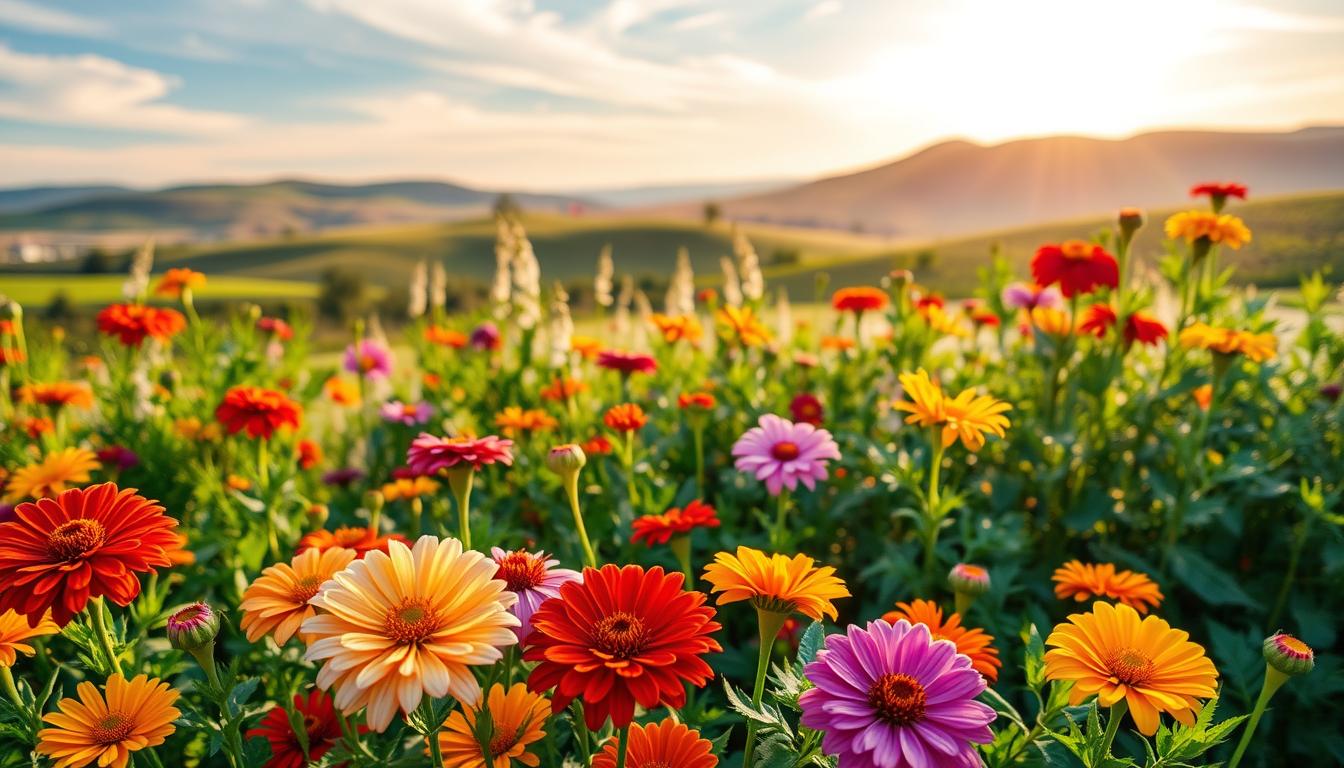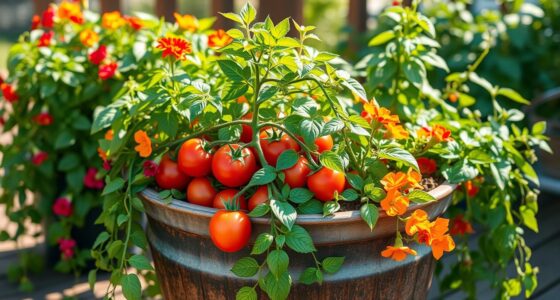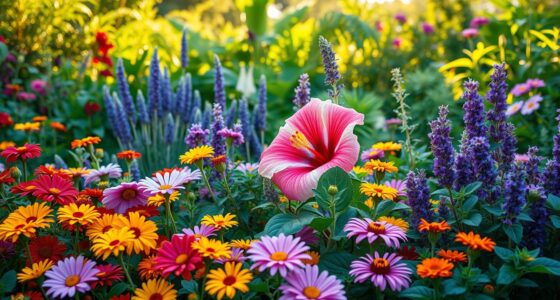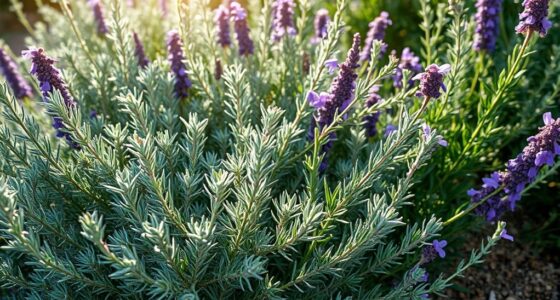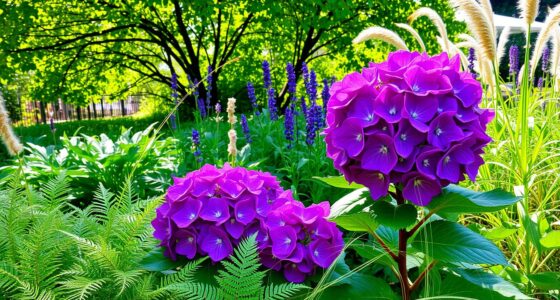Have you ever wandered through a garden and felt an immediate sense of joy as vibrant colors and gentle scents enveloped your senses? Perhaps you recall the delight of planting zinnias, those resilient blooms that seem to smile brightly in the sunlight. But did you know that the magic of your zinnias can be amplified through the art of companion planting? Selecting the right zinnia companion plants can transform your garden into a flourishing paradise, enhancing not only the beauty but also promoting a healthy garden ecosystem. Let’s dive into the world of zinnia planting partners, uncovering the best combinations that will elevate your gardening experience.
Key Takeaways
- Companion planting enhances the health and vibrancy of your zinnias.
- Choosing the best zinnia companion plants can attract beneficial insects.
- Certain plants can deter pests, improving your garden’s ecosystem.
- Strategic pairings enrich the visual beauty of your garden.
- Zinnias thrive alongside flowers, herbs, and vegetables.
Why Companion Planting Matters
Companion planting creates beneficial relationships among plants, promoting a thriving garden ecosystem. By carefully selecting your zinnia compatible plants, you can boost growth and vitality not only for zinnias but for other members of your garden community as well. Understanding the benefits of companion planting enables you to maximize your space, improve yields, and keep your plants healthy.
Benefits of Companion Planting
One of the key advantages of companion planting is enhanced biodiversity, which helps establish a balanced garden environment. Plants like marigolds and nasturtiums naturally deter pests, protecting your zinnia garden companions. This technique also leads to better nutrient uptake among neighboring plants, heightening their overall health. By bringing together a variety of compatible plants, you enrich the soil and encourage beneficial insects to visit your garden.
How It Affects Zinnias
Zinnias play a crucial role in attracting pollinators due to their vibrant flowers and sweet nectar. The presence of zinnias within your garden can enhance fruit set for nearby vegetables, leading to a more fruitful harvest. As you incorporate zinnia garden companions into your landscape, you create an inviting atmosphere for bees and butterflies, further promoting fruitful plant relationships. This teamwork among plants fosters resilience and beauty in your garden.

Ideal Zinnia Companion Plants
Choosing the right zinnia plant companions can create a thriving garden that attracts pollinators and repels pests. Understanding the strengths of various plants helps you make informed decisions for zinnia mixed plantings. Explore some of the best zinnia companion plants that enhance both beauty and health in your garden.
Marigolds: A Colorful Duo
Marigolds are among the top choices when considering zinnia plant companions. Not only do they bring vibrant colors, but they also play a vital role in pest management. These flowers repel unwanted insects like aphids while attracting beneficial pollinators. Planting marigolds alongside zinnias not only boosts aesthetic appeal but also promotes a healthier garden environment.
Basil: A Culinary Companion
Basil serves as a fantastic culinary companion to zinnias. Known for its aromatic leaves, basil not only enhances the flavor profile of neighboring vegetables but also attracts bees. Its presence in zinnia mixed plantings fosters an ecosystem that supports pollination and overall garden vitality. Pairing these two plants can enrich both your meals and your garden’s health.
Lettuce: A Perfect Ground Cover
Lettuce acts as an effective ground cover among zinnia plant companions. It helps retain moisture in the soil and suppresses weed growth, which can compete for nutrients. By incorporating lettuce into your zinnia mixed plantings, you create a nurturing environment that reduces competition and maintains healthy conditions for both plants to flourish.
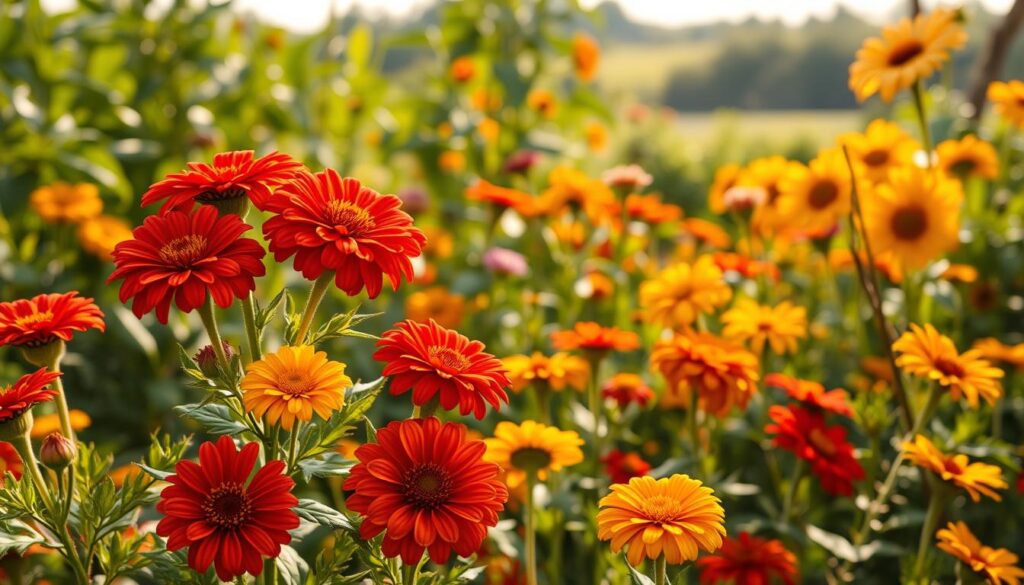
Herbs That Pair Well with Zinnias
Integrating herbs into your zinnia garden can create a lively and productive environment. Certain zinnia garden companions bring both beauty and practicality to your space. Embracing herbs such as oregano and dill enhances not only the aesthetics of your garden but also its functionality.
Oregano: A Flavorful Match
Oregano stands out as one of the best zinnia compatible plants. Its culinary appeal is undeniable, making it a valuable addition to any garden. Oregano’s rich aroma can help deter pests, fostering a healthier atmosphere for your zinnias. Additionally, this herb attracts beneficial insects, assisting in pollination and contributing to a vibrant ecosystem within your garden.
Dill: Enhancing Garden Aesthetics
Dill serves as an excellent counterpart to zinnias due to its delicate, feathery foliage. This herb not only increases visual interest but also attracts a variety of pollinators, enriching the biodiversity of your garden. Dill thrives under similar conditions as zinnias, making it a fitting choice when considering your zinnia garden companions.

| Herb | Benefits | Companion Plants |
|---|---|---|
| Oregano | Deters pests and attracts beneficial insects | Zinnias, tomatoes, and peppers |
| Dill | Attracts pollinators and enhances aesthetics | Zinnias, cucumbers, and carrots |
Vegetables as Zinnia Companions
When you cultivate a garden, combining various plants can enhance growth and beauty. Zinnia companion plants play a crucial role, especially when including vegetables like tomatoes and peppers. These vegetables not only thrive beside zinnias but also create a picturesque scene filled with vibrant colors.
Tomatoes: A Backyard Classic
Tomatoes and zinnias make an exceptional pairing. Zinnias attract beneficial pollinators, such as bees, which significantly contribute to the pollination of tomato plants. This relationship can lead to improved fruit yields in your garden. The colorful blooms of zinnias create a stunning backdrop for your tomato plants, further enhancing the aesthetic appeal of your zinnia flower bed companions.
Peppers: Spice Up Your Garden
Just like tomatoes, peppers benefit from being grown near zinnias. These vegetables embrace the influx of pollinators that zinnias attract, supporting their growth while adding a beautiful contrast with their colorful fruits. By integrating peppers into your garden alongside zinnias, you cultivate not only a thriving vegetable patch but also a dynamic and lively garden space.
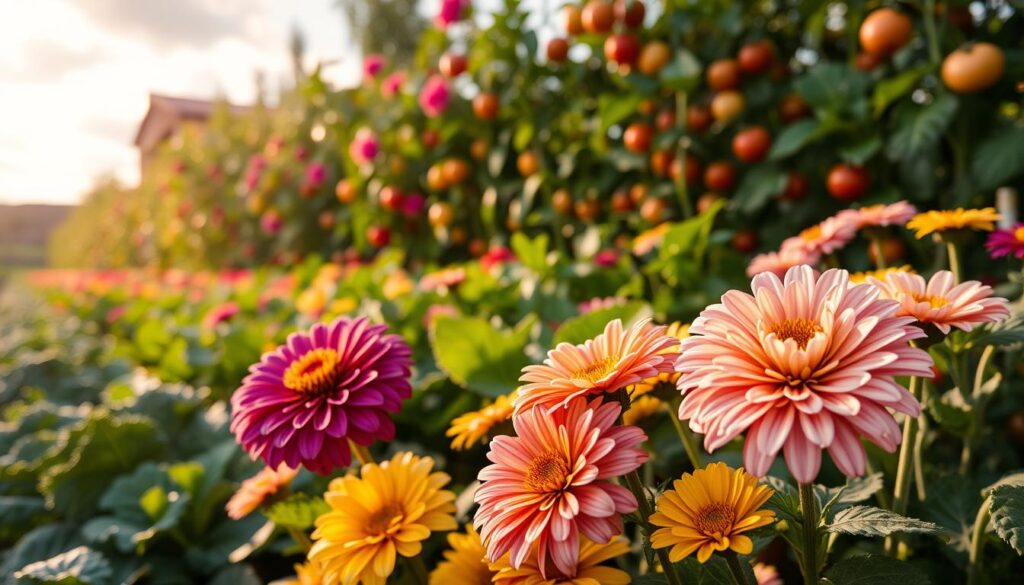
Attracting Beneficial Insects
Creating a vibrant garden goes beyond aesthetics. By focusing on zinnia garden companions, you can encourage a healthier ecosystem, particularly through attracting beneficial insects. Pollinators like bees and butterflies play a crucial role in not only enhancing the beauty of your garden but also in boosting its productivity.
Flowers to Encourage Pollinators
Incorporating a variety of flowers in your garden encourages a wealth of pollinators. Plants such as lavender, sunflowers, and, of course, zinnias, are excellent choices. Their bright colors and sweet nectar invite these crucial insects. With zinnias in particular, you’re creating a welcoming environment, ensuring that those beneficial insects thrive and return season after season, significantly improving pollination.
How Zinnias Help Other Plants
Zinnias contribute positively to the surrounding plants, enhancing their growth and health directly. By attracting beneficial insects, they promote better pollination rates across your garden. This symbiotic relationship does wonders for your vegetables and herbs, leading to a more diverse ecosystem. You may notice increased yields and lush plants, which is a delightful benefit of nurturing zinnia garden companions.
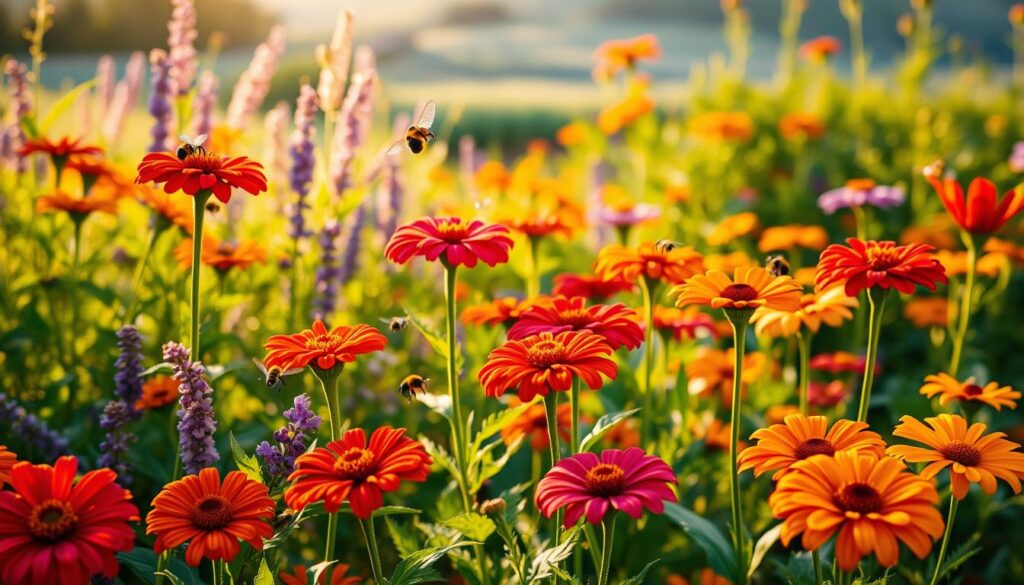
Repelling Pests Naturally
Utilizing natural pest control methods can significantly enhance your garden’s health and productivity. By incorporating zinnia companion plants that repel pests, you create a more resilient ecosystem. These plants contribute not only to the aesthetic appeal of your garden but also serve as natural barriers against harmful insects.
Using Companion Plants for Pest Control
Companion planting is an effective strategy to avoid chemical pesticides. Certain plants, such as marigolds and nasturtiums, possess properties that deter pests while attracting beneficial insects. This natural pest control technique keeps harmful species at bay and supports a balanced garden environment.
Examples of Effective Combinations
Pairing zinnias with other companion plants can create a formidable defense against pests. Here are some combinations to consider:
| Companion Plant | Pest It Repels | Additional Benefits |
|---|---|---|
| Marigolds | Nematodes, Whiteflies | Attracts pollinators, improves soil health |
| Nasturtiums | Aphids, Cabbage Worms | Edible flowers, enhances flavor of nearby crops |
| Rosemary | Cabbage Moths | Repels various harmful insects, aromatic herb |
| Garlic | Spider Mites, Aphids | Fungicide properties, natural flavor enhancer |
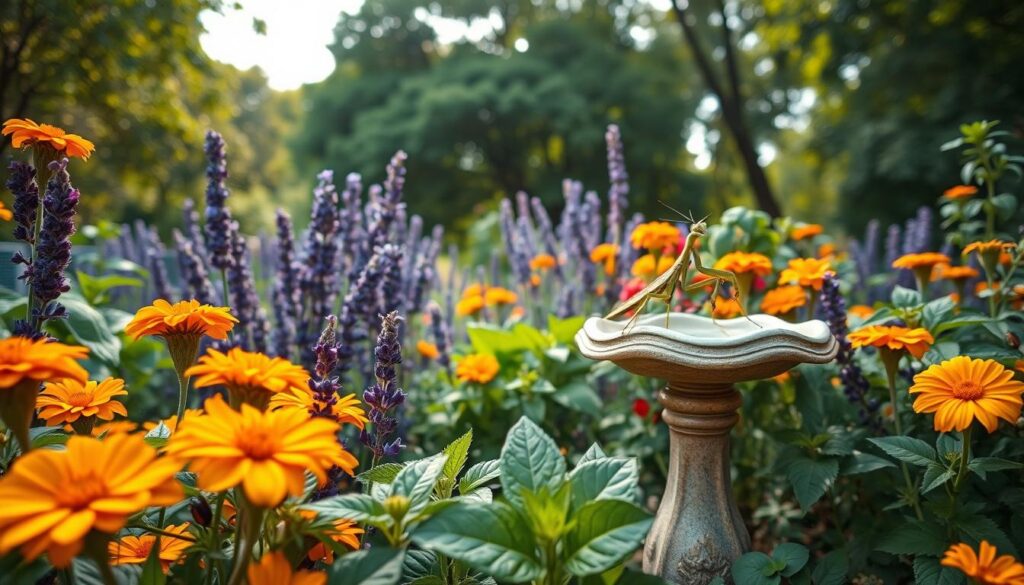
Incorporating these natural pest control methods using zinnia companion plants will lead to a healthier, more vibrant garden. By taking advantage of companion planting, you cultivate an environment that encourages growth and productivity without the reliance on chemical treatments.
Ground Covers That Benefit Zinnias
Incorporating ground cover plants for zinnias enhances both the visual appeal and functionality of your garden. These plants work diligently to suppress weeds while maintaining soil moisture, creating a thriving environment for your zinnia mixed plantings. By selecting the right ground cover, you can elevate your zinnias and cultivate a vibrant space.
Creeping Thyme: A Versatile Partner
Creeping thyme serves as an excellent choice for ground cover due to its drought-resistant properties and delightful fragrance. This plant thrives alongside zinnias, providing a rich tapestry of life. With its low-growing habit, it acts as a natural weed barrier, allowing your zinnias to flourish without competition. The blooms of creeping thyme can also attract pollinators, further benefiting your garden.
Sweet Potato Vine: Adding Texture
Sweet potato vine offers bold foliage and cascading growth, creating a stunning contrast with zinnias. This ground cover plant complements the brighter colors of zinnias while thriving in similar conditions. Its vibrant leaves add texture and depth, ensuring your garden remains visually interesting throughout the growing season. As sweet potato vine spreads, it contributes to moisture retention, creating an ideal habitat for your zinnias.

| Ground Cover Plant | Benefits | Compatibility with Zinnias |
|---|---|---|
| Creeping Thyme | Weed suppression, drought-resistant, attracts pollinators | Excellent |
| Sweet Potato Vine | Bold foliage, moisture retention, adds texture | Great |
Companion Plants for Different Zinnia Varieties
Choosing the right companions for your zinnias enhances both aesthetics and health. Different zinnia varieties have unique needs that can be met with compatible plants. Understanding which plants to pair ensures both beauty and function in your garden.
Zinnias and Dwarf Varieties
Dwarf zinnia varieties thrive when paired with low-growing plants. Consider using sweet alyssum or creeping thyme, as these options not only create a lush ground cover but also complement the vibrant blooms of dwarf zinnias. These zinnia flower bed companions do not overshadow the zinnias, allowing them to shine in their colorful glory.
Tall Zinnias: Space Considerations
Tall zinnias need strategically placed companions that offer support without crowding. Sunflowers, for example, can enhance the vertical aesthetics while ensuring the zinnias have enough room to grow tall. Maintaining adequate spacing between the taller plants and the zinnias promotes healthy airflow and minimizes competition for resources. Selecting appropriate zinnia compatible plants maximizes the beauty of your garden while ensuring each plant has space to thrive.
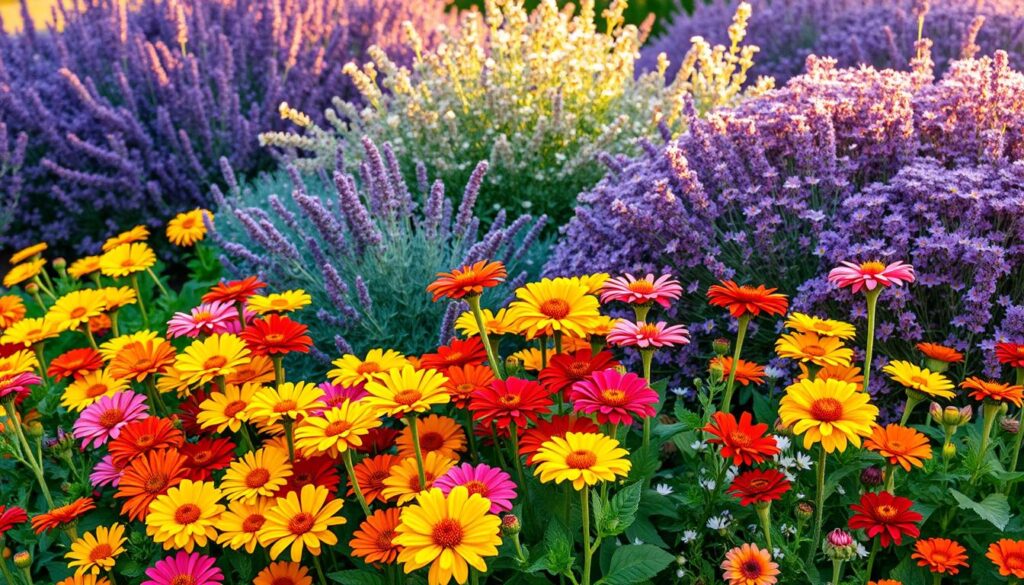
Seasonal Planting Tips
Getting the timing right for your zinnias and their companions can make a world of difference. Understanding the fundamentals of seasonal planting tips will help you create a flourishing garden. By synchronizing the planting of zinnias with compatible plants, you not only achieve better growth but also utilize your garden space effectively. Timing your companion planting can maximize the beauty and productivity of your outdoor space.
Timing Your Companion Planting
To ensure the best results, you will want to think about the bloom cycles of your zinnia planting partners. Start by assessing when your first frost is likely to occur in the spring. You can begin sowing seeds indoors or outdoors based on this date. Pair your zinnias with companion plants that thrive under similar conditions. For instance, if you plant marigolds alongside your zinnias, you can create a beautiful and vibrant display while simultaneously benefiting from marigolds’ pest-repelling properties.
Extending the Growing Season
Another strategy in your seasonal planting tips arsenal involves staggering sowing dates. This technique allows you to enjoy a longer blooming period. By planting new seeds every few weeks, you can maintain a colorful garden from late spring until the first frost. Additionally, incorporating different varieties of zinnias can enhance the aesthetic appeal, providing a rich palette of colors throughout the season. This method not only maximizes growth but also encourages a continuous presence of blooms, enriching your garden experience.

Zinnias in Container Gardens
Zinnias are fantastic for zinnia container gardening, adapting beautifully to pots and planters. Their vibrant blooms provide a burst of color while creating a welcoming atmosphere on patios and balconies. To maximize your container gardening space, consider pairing zinnias with complementary plants such as basil and marigolds. This combination not only enhances the visual appeal but also offers practical benefits, like pest control and improved growth for all your plants.
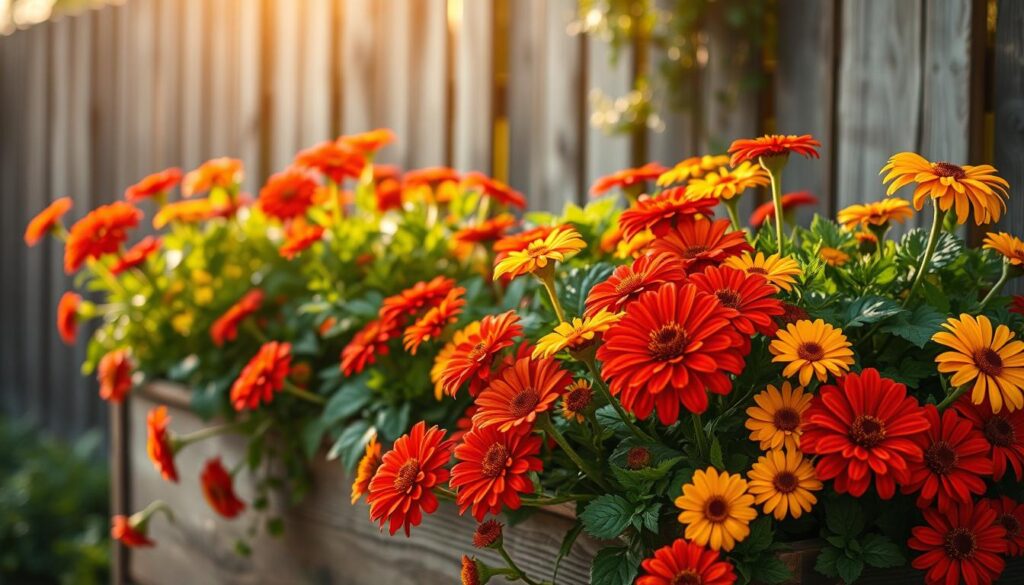
Best Companion Plants for Pots
- Basil: A culinary delight, basil not only adds flavor to your dishes but complements the zinnia’s striking appearance.
- Marigolds: Known for their pest-repelling qualities, marigolds create a beautiful color contrast to zinnias while protecting them.
- Petunias: These colorful flowers enhance the overall aesthetic and thrive alongside zinnias, creating a lush container garden.
Arrangement Ideas for Aesthetic Appeal
When arranging your zinnia garden companions in a container, aim for a mix of textures and heights. Tall zinnia varieties make a striking backdrop, while shorter companions can fill in the front. Layering plants not only improves visual depth but also optimizes light exposure and airflow. You might arrange a bold zinnia at the center, surrounded by fragrant basil and vibrant marigolds, for a stunning seasonal display that attracts pollinators and catches the eye.
Maintenance for Companion Plants
Caring for zinnia companion plants requires a thoughtful approach to ensure their health and longevity. Consistent garden maintenance tips play a vital role in creating an environment where both zinnias and their companions can flourish. With proper attention to watering and fertilization, you can nurture a vibrant garden ecosystem.
Common Care Tips for Zinnias and Friends
When it comes to maintaining zinnias alongside their companion plants, focus on providing adequate sunlight and ensuring proper spacing to promote air circulation. Regularly check for pests and diseases, as early detection can prevent significant issues. Mulching around your plants helps retain soil moisture while suppressing weeds. This practice benefits both zinnias and their companions by creating a stable growing environment.
Watering and Fertilization Needs
Establishing a deep watering regime is essential for zinnia companion plants. Aim for consistent moisture, allowing the soil to dry out slightly between watering to avoid waterlogging. Fertilizing with a balanced nutrient mix supports healthy growth. Tailoring your fertilization strategy to the specific needs of each plant will significantly contribute to a robust garden. This attentive approach to garden maintenance tips enhances the overall performance of your zinnia companions.
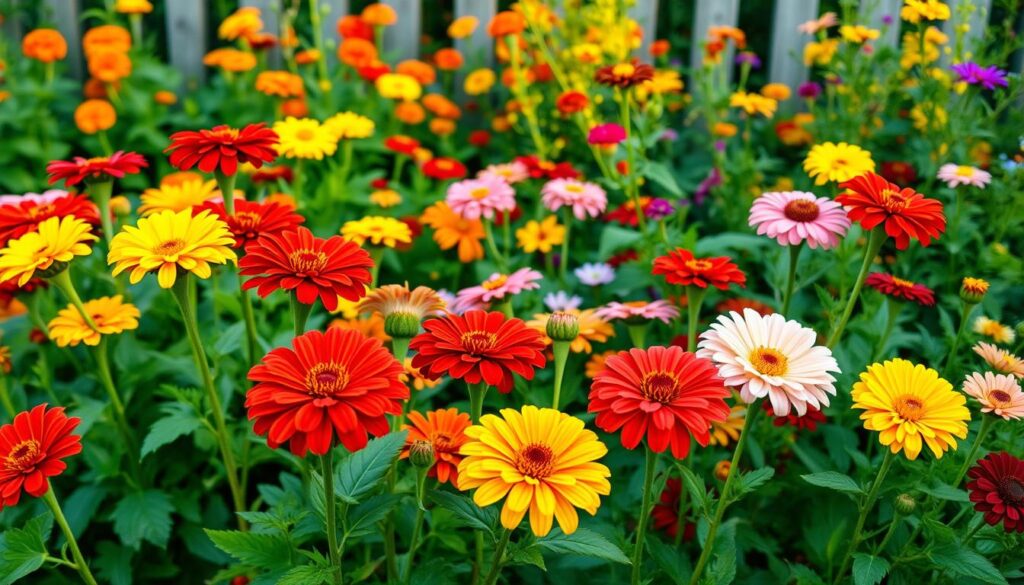
Troubleshooting Companion Plant Issues
As you cultivate a vibrant garden filled with zinnia compatible plants, you may encounter some common gardening issues that require attention. Recognizing the signs of poor companionship, such as stunted growth or increased pest problems, is vital for achieving a thriving garden ecosystem. Addressing these issues promptly will help keep your zinnias and their companions healthy.
Signs of Poor Companionship
Watch for several indicators that suggest your plant pairings may not be suiting each other well:
- Stunted Growth: If your zinnias appear smaller than expected, they might be competing too much for nutrients with other plants.
- Pest Infestations: Certain combinations can attract unwanted pests, hindering the overall health of your garden.
- Discoloration: Yellowing leaves can indicate stress, whether from insufficient light or nutrient competition.
- Wilting: A lack of moisture retention among incompatible plants may lead to wilting or browning.
Adjusting Plant Pairings
Once you’ve identified possible issues, adjusting your plant pairings can enhance your garden’s health. Consider the following strategies:
- Remove Incompatible Plants: If certain plants are not thriving next to your zinnias, swap them out for more compatible options.
- Reorganize Space: Give each plant adequate space to flourish, eliminating competition for light and nutrients.
- Substitute with Proven Companions: Introduce well-known zinnia compatible plants that thrive together, such as marigolds or basil, to promote a healthier environment.

Attracting Wildlife to Your Garden
Integrating zinnias into your landscape serves as an excellent strategy for attracting wildlife. The vibrant colors and rich nectar of zinnia garden companions create an inviting atmosphere for various species, notably birds and butterflies. These enchanting creatures enhance the liveliness of your garden while performing essential roles in pollination and natural pest control. Embracing the beauty of zinnias not only adds aesthetic value but also contributes to a thriving ecosystem in your yard.
Birds and Butterflies: Zinnia Benefits
Birds and butterflies are key players in a healthy garden, and zinnias play an important role in drawing them closer. Their blooms provide both a food source and an attractive habitat:
- Birds: Many species are drawn to the seeds produced by zinnias. Planting these flowers helps promote a diverse avian population.
- Butterflies: Zinnias offer abundant nectar, serving as a vital food supply during their critical life stages.
Creating a Balanced Ecosystem
A garden thriving in biodiversity is more resilient against pests and diseases. By incorporating zinnia garden companions, you foster a balanced ecosystem:
- Pollination: Birds and butterflies significantly boost pollination rates, benefiting not only zinnias but all nearby plants.
- Natural Pest Control: Attracting wildlife helps manage pest populations organically, enhancing overall garden health.
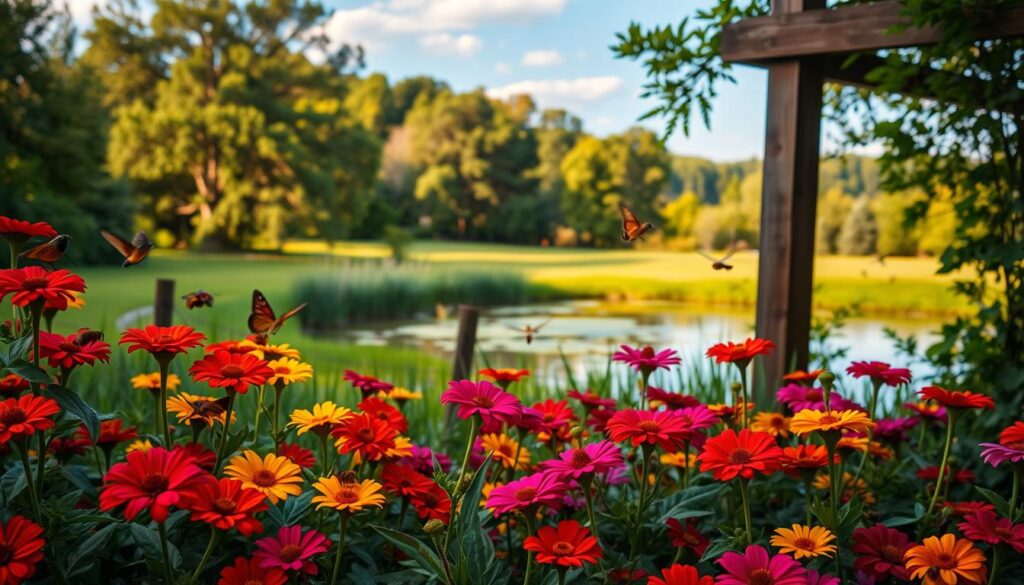
Harvesting Tips for Companion Plants
Understanding when and how to harvest your plants contributes significantly to your gardening success. Following efficient harvesting tips for zinnias not only enhances the appearance of your arrangements but also supports the healthy growth of your zinnia flower bed companions. Timing becomes essential both for zinnias and the vegetables that share their space.
When to Harvest Zinnia Flowers
To enjoy the full display of zinnia flowers, harvest them at their peak bloom. This stage reveals the most vibrant colors and sturdy petals. You should look for blossoms that are fully open, yet not wilted or past their prime. Snipping the stems as close to the base as possible encourages new blooms to emerge and keeps your flower bed looking healthy.
Enjoying Veggies from Your Garden
For vegetables thriving alongside your zinnias, the timing of harvest can significantly affect taste and quality. Pay attention to the signs of ripeness for each type of vegetable. Regular harvesting boosts the overall health of your companion plants and encourages them to produce more. For example, plucking ripe tomatoes or peppers can stimulate further fruiting and maintain the vigor of those plants.

| Companion Plant | Harvest Time | Harvest Tips |
|---|---|---|
| Zinnias | When blooms are fully open | Cut close to the base for new blooms |
| Tomatoes | When they are fully colored | Gently twist or cut stem |
| Peppers | At desired size and color | Pick by hand for less damage |
| Basil | Before flowering | Trim regularly to promote growth |
Final Thoughts on Zinnia Companions
Embracing the beauty of zinnia companion plants can transform your garden into a vibrant oasis. The joy of diverse planting goes beyond aesthetics; it encourages a richer experience in your gardening journey. By mixing different plants, you create an engaging environment that attracts various beneficial insects and enhances the overall health of your garden.
The Joy of Diverse Planting
As you explore different combinations of zinnia companion plants, you invite creativity into your gardening routine. This dash of experimental gardening not only beautifies your space but also fosters a thriving ecosystem within your garden. When you vary your selections, you may stumble upon unique pairings that enhance both growth and blooming potential.
Encouraging Experimentation in Your Garden
Don’t hesitate to test the waters when it comes to companions for your zinnias. Keep an eye out for new plant varieties and consider how they could interact with your existing plants. Each season offers a fresh opportunity for experimentation, allowing you to discover partnerships that flourish in your specific environment. This journey of exploration will ultimately enhance your gardening experience and inspire you to cultivate a lush, diverse landscape.
